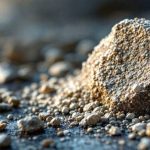Takeaways
- Copper supports collagen and elastin production
- It has antioxidant and antimicrobial properties
- Copper aids in wound healing and reduces inflammation
- Skincare products and supplements can provide copper benefits
- Dietary sources of copper contribute to skin health
- Balanced copper levels help combat signs of skin aging
Copper and Skin: An Overview
Copper is a crucial mineral that the body uses for many processes, including skin health.[1] It actively participates in several functions that contribute to keeping this largest organ healthy and vibrant.
The skin uses copper for various daily functions, from maintaining its structure to protecting against damage.[2] Understanding how copper supports skin health can aid in making better decisions about skincare and overall well-being.
Copper’s influence on skin goes beyond basic nutrition, affecting how it looks, feels, and how well it bounces back.[3] By supporting essential components and processes, copper helps keep skin healthy from the inside out.
The Science Behind Copper and Skin
Collagen Production
Copper is essential for the body’s production of collagen, a protein that provides structure and strength to the skin.[4] If the body doesn’t have enough copper, it cannot produce collagen effectively.
Collagen keeps the skin firm and resilient.[5] As people age, the production of collagen naturally decreases which can lead to wrinkles and sagging skin.[6] Copper helps maintain collagen levels, thus contributing to a more youthful appearance.[7]
Several factors can influence collagen production:
- Age
- Sun exposure
- Diet
- Copper levels in the body
Elastin Formation
Copper is also involved in the formation of elastin, another important skin protein.[8] Elastin allows the skin to stretch and return to its original shape.[9] This ability to bounce back is important for maintaining youthful, supple skin.[10]
Like collagen, elastin production also slows down as people age.[11] Copper supports the enzymes that create and maintain elastin, helping skin retain its elasticity and prevent premature sagging.[12]
Antioxidant Properties
Copper is a component of antioxidant enzymes in the body.[13] These enzymes help protect the skin from damage caused by free radicals, which are unstable molecules that can harm skin cells.[14]
Antioxidants neutralize free radicals, preventing potential harm.[15] This protection is essential for maintaining healthy and youthful skin.[16] Copper-containing antioxidants contribute to preventing premature aging and damage.[17]
| Oxidative Stress Source | Copper’s Protective Effect |
|---|---|
| UV radiation | Neutralizes free radicals |
| Pollution | Supports antioxidant enzymes |
| Stress | Helps repair cellular damage |
| Poor diet | Enhances overall skin health |
Copper’s Impact on Skin Conditions
Wound Healing
Copper is important in the process of wound healing.[18] It assists in the formation of new blood vessels, which is called angiogenesis, and this process is necessary for bringing nutrients to healing tissues.[19]
Copper also supports the production of new skin cells.[20] These replace damaged ones, which speeds up the healing of cuts and scrapes.[21] Having sufficient copper levels can lead to faster healing times.[22]
Copper’s role during wound healing is seen in these stages:
- Inflammation
- Blood vessel formation
- Collagen production
- Skin cell regeneration
- Wound closure
Inflammation Reduction
Copper has natural anti-inflammatory properties, which can be helpful for various skin issues.[23] Reducing inflammation can soothe irritated skin from conditions like acne or sunburn.[24]
By reducing inflammation, copper can help to decrease redness and swelling.[25] Because of this property, copper-infused products are often used by people with sensitive skin.[26] However, it is important to follow product directions to avoid irritation.[27]
Antimicrobial Effects
Copper has natural antimicrobial properties, meaning it can help fight off harmful bacteria on the skin.[28] By reducing bacteria, copper can help prevent acne and other skin infections.[29]
The antimicrobial effects of copper also extend to fungi and viruses.[30] This protection contributes to overall skin health and hygiene.[31] Some skincare products use this property to create cleaner, healthier skin.[32]
| Antimicrobial Agent | Effectiveness Against Bacteria | Effectiveness Against Fungi | Effectiveness Against Viruses |
|---|---|---|---|
| Copper | High | Moderate | Moderate |
| Silver | High | High | Low |
| Zinc | Moderate | High | Low |
| Tea Tree Oil | Moderate | High | Low |
Copper in Skincare Products
Types of Copper-Infused Products
Many skincare products now include copper, ranging from serums and creams to masks and tools.[33] Each product type is designed to deliver copper’s benefits to the skin in different ways.
Copper peptides are a common form of copper in skincare.[34] These compounds combine copper with amino acids.[35] This form is thought to be absorbed by the skin more easily.[36]
Common copper-infused skincare products include:
- Facial serums
- Night creams
- Eye creams
- Face masks
- Cleansing tools
Benefits and Effectiveness
Copper-infused skincare products claim to offer benefits such as reducing fine lines, improving skin texture, and enhancing skin repair. Some users have reported brighter and firmer skin with regular use.
Research into the use of copper in skincare shows some encouraging results. Studies have found that copper peptides can encourage collagen production. Other research suggests that copper can improve skin elasticity and reduce wrinkles.
However, further research is needed to fully understand how effective copper is in skincare. Results can vary based on the product and individual skin types. It is always a good idea to test new products and introduce them slowly.
Considerations and Precautions
While copper can benefit the skin, it is important to use copper-infused products correctly. Overuse may lead to irritation or other skin problems. Always follow product instructions and begin with less frequent use.
Some people might have sensitive skin when using copper. If redness, itching, or other irritation occurs, stop using the product. Consult with a dermatologist before using copper products if you have sensitive skin or any existing skin conditions.
Dietary Sources of Copper for Skin Health
Copper-Rich Foods
Getting enough copper through your diet is important for skin health. Many foods contain copper, making it relatively easy to meet daily needs with a balanced diet.
Eating a variety of foods that are rich in copper can support overall skin health. These foods often contain other nutrients that are also good for the skin, creating a combined positive effect.
Top copper-containing foods that can benefit the skin include:
- Oysters
- Beef liver
- Dark chocolate
- Sunflower seeds
- Cashews
- Lentils
- Mushrooms
- Avocados
Recommended Intake
The recommended daily intake of copper for adults is approximately 900 micrograms. This amount is typically easy to get from a balanced diet. Most people do not need copper supplements unless advised by a doctor.
Copper from your diet contributes to overall skin health in several ways. It helps with collagen and elastin production, strengthens antioxidant defenses, and aids in skin cell regeneration. Eating various copper-rich foods can help keep skin healthy and vibrant.
Copper Deficiency and Skin
Signs and Symptoms
A copper deficiency can have a negative impact on skin health. Although it’s not common in developed countries, it can lead to various skin problems. Recognizing these signs can help identify a potential copper deficiency early.
Skin problems are often among the first noticeable signs of a copper deficiency. These can range from minor issues to more serious skin conditions. If you notice ongoing skin problems, it’s worth discussing them with a healthcare provider.
Symptoms of copper deficiency related to skin can include:
- Pale or sallow skin
- Premature gray hair
- Skin pigmentation changes
- Slow wound healing
- Increased susceptibility to infections
Risk Factors
Several factors can increase the risk of a copper deficiency. Some factors are directly related to skin health, while others affect overall body function. Knowing these risk factors can help prevent a deficiency.
Certain medical conditions and treatments can interfere with the absorption of copper. For example, gastric bypass surgery can reduce the amount of copper absorbed by the body. Taking too much zinc can also interfere with copper absorption, as the body uses the same method to absorb them.
Copper Supplementation for Skin Health
Forms of Copper Supplements
Copper supplements are available in various forms, including copper gluconate, copper sulfate, and copper oxide. Each form has different rates of absorption and potential benefits for skin health.
Copper supplements can help skin health by ensuring the body has enough copper. This can support the production of collagen, boost antioxidant defenses, and help with skin repair processes.
Dosage and Safety
The recommended dosage for copper supplements depends on individual needs. Most supplements contain between 1 to 3 mg of copper per day. It’s important not to exceed 10 mg per day, as too much copper can be harmful.
Safety is very important when considering copper supplements. While copper is necessary for health, too much copper can cause problems. Always talk with a healthcare provider before starting any new supplement routine.
Steps to safely incorporate copper supplements into your routine:
- Consult a healthcare provider
- Choose a reputable supplement brand
- Start with a low dose
- Monitor for any side effects
- Adjust dosage as needed under medical supervision
Copper and Aging Skin
Age-Related Skin Changes
As people age, their skin goes through various changes, which affect how it looks, feels, and functions. Understanding these changes helps in taking better care of aging skin.
Copper plays a role in many of these age-related skin changes. Because it is involved in the production of collagen and elastin, it is especially important for aging skin. Maintaining sufficient levels of copper may help slow down some of the effects of aging.
Copper’s Potential Anti-Aging Effects
Copper may help fight signs of aging skin through its role in collagen and elastin production, which support skin structure and elasticity. This can help reduce the appearance of fine lines and wrinkles.
Current research into copper’s anti-aging properties is encouraging. Studies have shown that copper peptides can stimulate collagen production in older skin. Other research suggests that copper can improve skin elasticity and firmness.
Copper in Professional Skin Treatments
Copper Peptides in Skincare
Copper peptides are a popular ingredient in professional skin treatments. These compounds combine copper with small protein pieces. This form is thought to make copper’s skin benefits stronger.
Professional treatments using copper peptides are designed to improve skin texture and appearance. These treatments may include facials, peels, or microneedling with copper peptide serums. Results can vary, but many people report improvements in skin firmness and reduced signs of aging.
Other Copper-Based Treatments
Besides copper peptides, other copper-based treatments are used in professional skincare, including copper-infused masks, copper-tipped tools, or even copper-based light therapies. Each treatment is designed to utilize copper’s skin benefits in different ways.
Professional copper-based treatments may offer benefits for various skin concerns. These may include reducing signs of aging, improving skin texture, or enhancing overall skin health. As with any treatment, results can vary, and it’s important to consult with a skincare professional.
FAQ: Copper and Skin Health
Is copper safe for all skin types?
Can copper in skincare products cause skin discoloration?
How long does it take to see results from copper-infused skincare products?
Can copper supplements improve skin health?
Is it possible to get too much copper from skincare products?
How does copper compare to other minerals for skin health?
Conclusion
Copper is essential for maintaining healthy skin. It supports collagen production and enhances wound healing, contributing to many aspects of skin function. Understanding the role of copper can help in making good choices about skincare and nutrition.
Future research into copper and skin health is promising. Scientists continue to explore new ways to utilize copper’s benefits for the skin. This may lead to more effective skincare products and treatments in the future.
Adding copper to your skincare routine doesn’t have to be difficult. Eating a balanced diet that is rich in copper-containing foods is a good start. For those interested in copper-infused products, many choices are available. As always, consulting with a skincare professional or dermatologist for personalized advice is best.
Remember, while copper offers many benefits for skin health, it is only one part of the picture. A well-rounded approach to skincare, including proper cleansing, sun protection, and overall healthy habits, will produce the best results for your skin.
Copper is a vital cofactor for enzymes involved in collagen and elastin production, melanin synthesis, and antioxidant defense, all of which contribute to skin health.
Source: “Recent advances in molecular mechanisms of skin wound healing and its treatments” https://www.ncbi.nlm.nih.gov/pmc/articles/PMC11148235/
Copper is essential for the proper function of enzymes like lysyl oxidase, which is needed for cross-linking collagen and elastin fibers, and superoxide dismutase, an antioxidant enzyme.
Source: “Antimicrobial second skin using copper nanomesh” https://www.ncbi.nlm.nih.gov/pmc/articles/PMC9214522/
Copper’s influence extends beyond basic nutrition, impacting skin elasticity, tone, and the ability to repair damage, leading to overall skin health and appearance.
Source: “Recent advances in molecular mechanisms of skin wound healing and its treatments” https://www.ncbi.nlm.nih.gov/pmc/articles/PMC11148235/
Collagen synthesis requires the action of copper-dependent enzymes. Insufficient copper can lead to impaired collagen formation, affecting the skin’s structural integrity.
Source: “Recent advances in molecular mechanisms of skin wound healing and its treatments” https://www.ncbi.nlm.nih.gov/pmc/articles/PMC11148235/
Collagen fibers form a network in the dermis that supports skin structure, providing strength and resilience.
Source: “Recent advances in molecular mechanisms of skin wound healing and its treatments” https://www.ncbi.nlm.nih.gov/pmc/articles/PMC11148235/
The decline in collagen synthesis and increase in its degradation lead to thinner and less elastic skin, resulting in the formation of wrinkles and sagging.
Source: “Research Progress in Skin Aging, Metabolism, and Related Products” https://www.ncbi.nlm.nih.gov/pmc/articles/PMC10647560/
Copper’s role in collagen synthesis is vital for maintaining skin elasticity and structure, contributing to a more youthful appearance and minimizing the effects of aging.
Source: “Recent advances in molecular mechanisms of skin wound healing and its treatments” https://www.ncbi.nlm.nih.gov/pmc/articles/PMC11148235/
Like collagen, elastin synthesis and stabilization rely on copper-dependent enzymes. Adequate copper is essential for healthy elastin production.
Source: “Recent advances in molecular mechanisms of skin wound healing and its treatments” https://www.ncbi.nlm.nih.gov/pmc/articles/PMC11148235/
Elastin fibers in the dermis allow the skin to return to its original shape after stretching or distortion.
Source: “Role of elastic fiber degradation in disease pathogenesis” https://www.ncbi.nlm.nih.gov/pmc/articles/PMC11659964/
The ability of skin to recoil and maintain its shape is essential for a youthful appearance, preventing sagging and wrinkles.
Source: “Role of elastic fiber degradation in disease pathogenesis” https://www.ncbi.nlm.nih.gov/pmc/articles/PMC11659964/
The age-related decrease in elastin synthesis and increase in its breakdown leads to the loss of skin elasticity and the formation of wrinkles.
Source: “Role of elastic fiber degradation in disease pathogenesis” https://www.ncbi.nlm.nih.gov/pmc/articles/PMC11659964/
By supporting elastin production, copper can help maintain skin elasticity and prevent premature sagging, which are common signs of aging.
Source: “Recent advances in molecular mechanisms of skin wound healing and its treatments” https://www.ncbi.nlm.nih.gov/pmc/articles/PMC11148235/
SOD requires copper to neutralize free radicals, thus preventing oxidative stress and damage to cells, including skin cells.
Source: “Antimicrobial second skin using copper nanomesh” https://www.ncbi.nlm.nih.gov/pmc/articles/PMC9214522/
Free radicals cause oxidative stress, damaging skin cells and contributing to premature aging. Antioxidants neutralize these molecules to protect the skin.
Source: “Reactive oxygen species, toxicity, oxidative stress, and antioxidants: chronic diseases and aging” https://www.ncbi.nlm.nih.gov/pmc/articles/PMC10475008/
Antioxidants help to minimize the damaging effects of free radicals, which can lead to premature aging, inflammation, and cellular dysfunction.
Source: “Reactive oxygen species, toxicity, oxidative stress, and antioxidants: chronic diseases and aging” https://www.ncbi.nlm.nih.gov/pmc/articles/PMC10475008/
Neutralizing free radicals reduces oxidative stress, which is a primary contributor to aging and skin damage, thus helping maintain healthy skin.
Source: “Reactive oxygen species, toxicity, oxidative stress, and antioxidants: chronic diseases and aging” https://www.ncbi.nlm.nih.gov/pmc/articles/PMC10475008/
SOD, which requires copper, is a critical antioxidant in the skin. Its role in neutralizing free radicals contributes to preventing signs of premature aging and damage.
Source: “Antimicrobial second skin using copper nanomesh” https://www.ncbi.nlm.nih.gov/pmc/articles/PMC9214522/
Copper is involved in angiogenesis, collagen synthesis, and the formation of new skin cells, all of which are essential for wound healing.
Source: “Recent advances in molecular mechanisms of skin wound healing and its treatments” https://www.ncbi.nlm.nih.gov/pmc/articles/PMC11148235/
Angiogenesis ensures sufficient blood supply to the wound site, which is essential for the delivery of oxygen and nutrients needed for tissue repair.
Source: “Recent advances in molecular mechanisms of skin wound healing and its treatments” https://www.ncbi.nlm.nih.gov/pmc/articles/PMC11148235/
Copper is involved in the cellular processes that lead to the formation of new skin cells, which are essential for replacing damaged tissues.
Source: “Recent advances in molecular mechanisms of skin wound healing and its treatments” https://www.ncbi.nlm.nih.gov/pmc/articles/PMC11148235/
The replacement of damaged cells with new ones is essential for the proper healing of cuts, scrapes, and other wounds.
Source: “Recent advances in molecular mechanisms of skin wound healing and its treatments” https://www.ncbi.nlm.nih.gov/pmc/articles/PMC11148235/
Copper’s multiple roles in angiogenesis, collagen synthesis, and cellular proliferation are essential for accelerating wound healing.
Source: “Recent advances in molecular mechanisms of skin wound healing and its treatments” https://www.ncbi.nlm.nih.gov/pmc/articles/PMC11148235/
Copper’s anti-inflammatory actions can help to reduce skin irritation and swelling associated with various skin conditions.
Source: “Recent advances in molecular mechanisms of skin wound healing and its treatments” https://www.ncbi.nlm.nih.gov/pmc/articles/PMC11148235/
Inflammation causes redness, swelling, and discomfort in skin conditions. Reducing inflammation can soothe the skin and aid in healing.
Source: “Chronic inflammation and the hallmarks of aging” https://www.ncbi.nlm.nih.gov/pmc/articles/PMC10359950/
Copper’s action in reducing inflammation contributes to visible improvements like decreased redness and swelling, improving the overall appearance of the skin.
Source: “Recent advances in molecular mechanisms of skin wound healing and its treatments” https://www.ncbi.nlm.nih.gov/pmc/articles/PMC11148235/
The soothing effects of copper may make it suitable for use in sensitive skin formulations to reduce irritation and promote skin health.
Source: “Recent advances in molecular mechanisms of skin wound healing and its treatments” https://www.ncbi.nlm.nih.gov/pmc/articles/PMC11148235/
Overuse or incorrect application of copper products may lead to skin irritation, redness, or other side effects. Always adhere to product instructions.
Copper ions can disrupt bacterial cell membranes and interfere with bacterial functions, thus reducing bacterial populations.
Source: “A review on synthetic account of 1,2,4-oxadiazoles as anti-infective agents” https://www.ncbi.nlm.nih.gov/pmc/articles/PMC8727175/
Copper’s action in killing or inhibiting bacteria can help prevent or manage skin conditions caused by bacterial infections.
Source: “A review on synthetic account of 1,2,4-oxadiazoles as anti-infective agents” https://www.ncbi.nlm.nih.gov/pmc/articles/PMC8727175/
Copper ions can disrupt fungal and viral structures and interfere with their replication processes, resulting in broad-spectrum antimicrobial activity.
Source: “A review on synthetic account of 1,2,4-oxadiazoles as anti-infective agents” https://www.ncbi.nlm.nih.gov/pmc/articles/PMC8727175/
By reducing bacteria, fungi, and viruses, copper helps to promote a cleaner, healthier skin environment, reducing the risk of infections.
Source: “A review on synthetic account of 1,2,4-oxadiazoles as anti-infective agents” https://www.ncbi.nlm.nih.gov/pmc/articles/PMC8727175/
Copper is included in some products for its antibacterial, antifungal, and antiviral properties, which help reduce skin infections and promote a healthy skin barrier.
Source: “A review on synthetic account of 1,2,4-oxadiazoles as anti-infective agents” https://www.ncbi.nlm.nih.gov/pmc/articles/PMC8727175/
The range of copper-containing skincare products highlights the variety of ways the mineral can be used topically for skin benefits.
Copper peptides combine copper with small protein fragments, making them more bioavailable for skin absorption.
Source: “Recent advances in molecular mechanisms of skin wound healing and its treatments” https://www.ncbi.nlm.nih.gov/pmc/articles/PMC11148235/
The combination of copper with amino acids enhances the skin’s absorption of copper and its effectiveness.
Source: “Recent advances in molecular mechanisms of skin wound healing and its treatments” https://www.ncbi.nlm.nih.gov/pmc/articles/PMC11148235/
The peptide carrier allows the copper to bypass some of the skin’s natural barrier properties, enhancing its bioavailability.
Source: “Recent advances in molecular mechanisms of skin wound healing and its treatments” https://www.ncbi.nlm.nih.gov/pmc/articles/PMC11148235/



